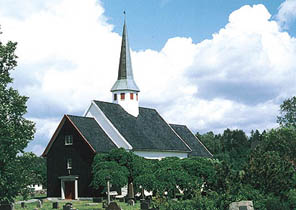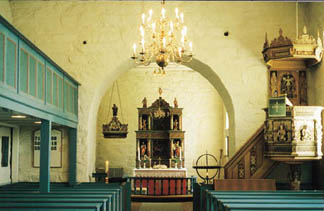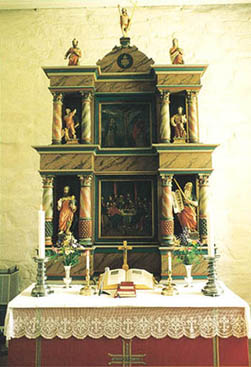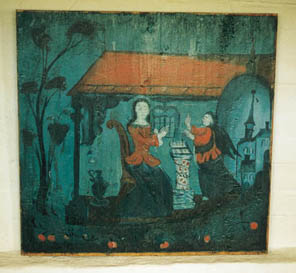| VÅLER CHURCH IN ØSTFOLD |
||||
|
||||
 |
||||
Våler church is beautifully situated by the ancient chieftancy in Fledsberg. The landscape is characterised by agricultural fields, backed by tree-covered hills, with a small brook running nearby. The church is built in a romantic style, believed to be from the late 1100s. Rather than grandiose and ornate, it is a solid "user's" church where local people have worshipped for 800 years. Within its inventory there is much of important cultural value, some of the individual pieces representing among the finest examples of their type in the country. While highly doubtful that this church was the first in Våler, archeologically excavations undertaken in 1962 have given no indications that an older church stood on the same site at an earlier time. The churchyard surrounds the church, the perimeter of which is designated by a stone wall that was built in 1854. |
||||

|
||||
The church is built on clay soil and has a stone foundation. Major portions of the walls are quarried stone filled with lime mortar. The stones of the corners and door are somewhat chiselled. The church has been through many changes. The southern door, the facade of which is still visible, was walled up already during the Middle Ages. The arch above the chancel - was originally 1.5 meters in breadth, and was widened to 3.8 meters in 1714. The western door had the same breadth as the original arched chancel until the western wall was torn down in 1867. A new church vestibule was erected at the same time, including an enlarged balcony area for the organ. During the same restoration, the windows in both the sanctuary and the chancel were enlarged. The church had a steeple and a vestibule already in 1620. There are references to a vestry already in 1821, but a new one was built in 1867. The vaulted ceilings in both the sanctuary and the chancel, as well as their supports, are dated from the renovations done in 1714. During the last major renovations, 1961-1963, the windows in the northern walls in both the sanctuary and the chancel were walled up. A new floor was laid and vestry built, while the vestibule and gables were newly panelled. Electrical panel ovens replaced the wood stoves at this time. During the Middle Ages, the church had the main altar within the chancel (most likely dedicated to the Virgin Mary). A side altar, referred to as a cross-altar, was located at approximated the same place where the pulpit stands today. The current interior is influenced by the 17th and 18th centuries. The church had fastened pews already from the 1500s. The altarpiece was a gift from the parish pastor Peder Hansøn Prydz and his wife Karen Olsdatter in 1636. The pulpit is from the same year. The baptismal font, with a vaulted ceiling, is from 1697. In 1791, the church received its first organ. The paintings hung on the northern wall of the sanctuary are from the same period. |
||||

|
||||
The altarpiece from 1636 has painted panels depicting the Lord's Supper and the Resurrection. On the left side of the picture of the crucifixion stands the evangelist Matthew with his symbol of the angel and Luke with the ox. On the right side, stand the evangelist Mark with the lion and John with the eagle. These statues together with Moses and Aaron (to the right and left of the picture of the Lord's supper) are among the finest to be found in Norwegian churches. The altar table is believed to be from 1867 and the framing of the altarpiece is from the 1960's. The original altar railing from 1714 was restored in 1867. | ||||

|
||||
The Pulpit The Baptismal Font The Organs The Crucifix |
||||

|
||||
The Paintings On the columns beneath the gallery hang two sculptures: St. Peter with the Keys and St. John with the Chalice. The 24-armed candle chandelier in the sanctuary and the 6-armed one in the choir are gifts from Tora Erlandsen in 1931 and 1934 respectively. The Psalms board is believed to be from 1780 and is among the oldest in the country. A leather bound chair from the last part of the 1600's was painted again in 1754. The Church Bells Harald Sandbæk, for the Våler Church Council. Cassandra Bergstrøm April - 2000 |
||||
[Home] [Church] [Orgel] [Historikk] [Kirken] [Prosjekter] [Reportasjer] [Gave] [Takk] [Tilbakemelding] [Restaureringen] |
||||